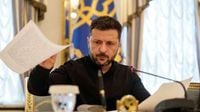In a tense and potentially perilous chapter of the ongoing conflict between Russia and Ukraine, Europe’s largest nuclear power station, the Zaporizhzhia plant, has now been operating without its main external power supply for more than nine days, relying on emergency diesel generators to cool its reactors and spent fuel. The plant, which sits ominously just 500 kilometers from the infamous Chornobyl disaster site, finds itself at the epicenter of international concern as fighting rages on nearby.
According to reports from Economic Times and Moneycontrol, the last remaining external power line to the Zaporizhzhia plant was severed during hostilities on September 23, 2025. Since then, the massive Soviet-era facility, which houses six VVER-1000 V-320 water-cooled and water-moderated reactors using Uranium 235, has been dependent on its backup diesel generators. Russian authorities, who have held the plant since seizing it in the early weeks of the 2022 invasion, insist that the generators are currently sufficient and that only some are being used at any given time. Yet, the situation remains precarious, with Ukrainian and international officials warning of the risk of a nuclear accident should power not be restored promptly.
The International Atomic Energy Agency (IAEA), the United Nations’ nuclear watchdog, has repeatedly sounded the alarm over the dangers posed by the ongoing fighting around Zaporizhzhia and other Ukrainian nuclear facilities. IAEA Director General Rafael Grossi put it bluntly: "Europe's largest nuclear power plant has been without external power for more than a week now, which is by far the longest lasting such event during more than three and a half years of war." He stressed that while the current status of the reactor units and spent fuel is stable, "it is extremely important that offsite power is restored." Grossi further explained, "The current status of the reactor units and spent fuel is stable as long as the emergency diesel generators are able to provide sufficient power to maintain essential safety-related functions and cooling."
Though all six reactors at Zaporizhzhia are currently shut down and cooler than they would be during normal operations, the risk is far from negligible. Nuclear plants require a constant supply of power to pump water and keep the reactors and spent fuel from overheating. Without this cooling, a meltdown could occur—an outcome with catastrophic consequences, especially given the plant’s proximity to Chornobyl, the site of the world’s worst nuclear disaster in 1986.
Ukrainian President Volodymyr Zelensky, in a somber address on September 30, 2025, highlighted the gravity of the situation: "It has been seven days now. There has never been anything like this before. The situation is critical." He warned that the blackout posed "a threat to everyone." Zelensky also revealed that one of the backup diesel generators had malfunctioned during this period, raising further alarms about the plant’s ongoing safety.
The dispute over responsibility for the current crisis is as fierce as the fighting itself. Moscow and Kyiv have traded accusations, each blaming the other for attacks that damaged the external power lines. Zelensky accused Russian forces of "obstructing the repair" of the crucial lines through targeted airstrikes, stating, "Due to Russian attacks, the plant has been cut off from its power supply and the electricity grid. It is being supplied with electricity from diesel generators." On the other side, Russian officials claim that the plant has been receiving backup power since an attack they attribute to Ukraine, and insist that all essential safety equipment is functioning normally for now.
Since the start of the war, the Zaporizhzhia plant, located near the city of Energodar along the Dnieper River and close to the shifting front lines, has faced a barrage of safety threats. These include not only frequent shelling and power outages, but also staff shortages as the conflict has driven many workers away or made it dangerous for them to reach the facility. Before Russia’s takeover in early 2022, the plant was a linchpin of Ukraine’s energy infrastructure, producing about a fifth of the nation’s electricity. Now, with all reactors shut down, its primary mission is to avoid disaster.
Radiation levels at the plant remain within normal limits, according to both IAEA and Russian statements, offering some reassurance to the millions living in the region and across Europe. But as the IAEA has repeatedly pointed out, this stability is contingent on the continued operation of the diesel generators—machines never intended to serve as a long-term substitute for external power. The current episode marks the longest such outage at Zaporizhzhia since the war began, underscoring just how fragile the situation has become.
For Ukrainians and their government, the ongoing crisis at Zaporizhzhia is a grim reminder of the broader vulnerabilities wrought by war. The plant’s predicament is not just a technical or environmental issue, but a matter of national security and public safety. Zelensky’s warning that "this is a threat to absolutely everyone" resonated far beyond Ukraine’s borders, as experts and policymakers across Europe and around the globe keep a wary eye on developments.
The IAEA’s Grossi and other international observers have called for an immediate cessation of hostilities around nuclear sites and for all parties to facilitate the restoration of external power to Zaporizhzhia. The agency’s inspectors have maintained a presence at the plant throughout the conflict, working under difficult conditions to monitor safety and provide independent assessments. Their message has been consistent: the risk of a major nuclear accident grows with each passing day that the plant operates on emergency power alone.
Meanwhile, the political and military standoff shows no sign of abating. Russia’s continued occupation of the plant complicates efforts to repair damaged infrastructure, as Ukrainian crews are often unable to reach the site safely. Each side remains deeply suspicious of the other’s intentions, with both Moscow and Kyiv accusing their adversaries of recklessness and bad faith. The result is a stalemate that leaves the Zaporizhzhia plant—and all those living in its shadow—dangerously exposed.
As the conflict grinds on, the world watches anxiously, hoping that cooler heads will prevail and that the worst-case scenario—a meltdown at Europe’s largest nuclear facility—can be averted. For now, the fate of Zaporizhzhia hangs in the balance, its reactors quiet but its risks all too real.




